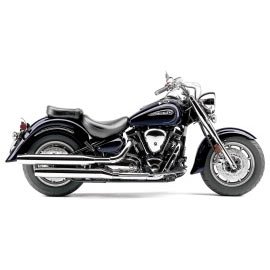Yamaha XV 1700 Road Star (2004–2015): A Timeless Cruiser with Muscle and Soul
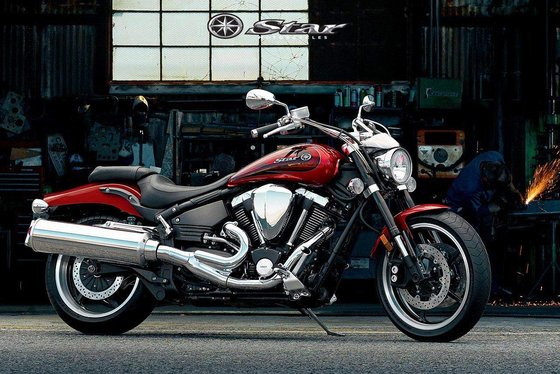
When Yamaha unleashed the XV 1700 Road Star in 2004, it wasn’t just launching another cruiser—it was cementing a legacy. For over a decade, this machine dominated the “big twin” segment with a combination of brute-force torque, retro-inspired styling, and engineering that prioritized rider satisfaction over gimmicks. Whether you’re a long-distance tourer, a weekend warrior, or a customization enthusiast, the Road Star’s DNA is etched into the golden era of air-cooled V-twins. Let’s dive into what makes this motorcycle a standout, even years after its final production run.
Design and Styling: Classic Cruiser Charisma
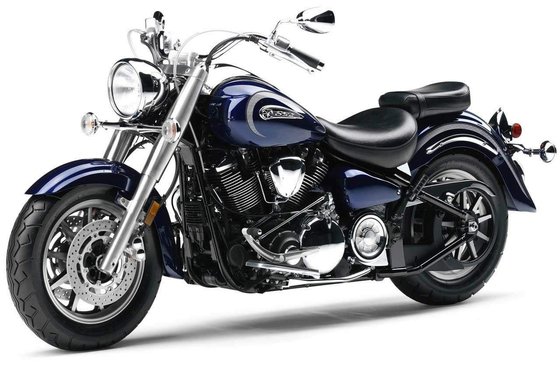
The Road Star’s design is a masterclass in balancing nostalgia with purpose. Its long, low-slung profile (wheelbase: 1,689 mm / 66.5 in) and 32-degree rake scream classic Americana, while details like the deeply valanced steel fenders and staggered dual exhausts add a touch of timeless elegance. The aluminum double-cradle frame isn’t just lightweight—it’s cleverly designed to mimic the “hardtail” look of vintage choppers, even though the hidden rear shock offers modern comfort.
Key Aesthetic Features:
- Chrome Accents: From the 43mm forks to the engine covers, the Road Star gleams with high-quality chrome, especially on later “S” and “Midnight” models.
- LED Taillight: The diamond-shaped LED taillight (a rarity in its era) looks custom-built, blending retro vibes with modern efficiency.
- Paint Schemes: Lustrous metallic finishes like Raven/Raspberry and Pearl White (early models) evolved into moody black lacquer for the Midnight edition, appealing to riders who prefer a sinister aesthetic.
The Road Star doesn’t shout for attention—it commands it. Even parked, its presence is undeniable.
Engine Performance: The Heart of a Blue-Collar Beast

At the Road Star’s core lies its 1,670cc air-cooled V-twin, a pushrod-operated powerhouse that feels like it was forged in the golden age of motorcycling. With 106.3 lb-ft (14.7 kgf-m) of torque peaking at a lazy 2,500 RPM, this engine isn’t about redline heroics—it’s about effortless authority.
Riding the Torque Wave:
- Low-End Grunt: Crack the throttle, and the Road Star surges forward with a visceral, chest-thumping pulse. The 113mm stroke ensures even highway overtakes require minimal downshifts.
- Fuel Injection vs. Carburetor: Early models (2004–2007) used a Mikuni BSR40 carburetor, while 2008–2015 variants switched to fuel injection. The latter offers smoother cold starts and altitude adaptability, but purists will argue the carbureted version has a rawer, more organic feel.
- Belt Drive: Yamaha’s belt final drive is practically bulletproof. It’s quiet, requires no lubrication, and transmits power seamlessly—a welcome break from chain maintenance.
The engine’s air cooling is a double-edged sword. While it maintains the classic look and reduces complexity, prolonged traffic crawls on hot days can turn the rider’s calves into rotisserie chicken. That said, the ceramic-composite cylinder liners and hydraulic valve lifters ensure longevity with minimal upkeep.
Riding Experience: Where Comfort Meets Attitude

Swing a leg over the Road Star’s 28-inch (710mm) seat, and you’re greeted by a riding position that prioritizes relaxation. The rubber-mounted, 1-inch handlebars sweep back toward the rider, while the floorboards (not pegs!) let you stretch out like you’re lounging in a La-Z-Boy.
On the Road:
- Highway Cruising: In 5th gear, the engine loafs at 2,800 RPM at 70 mph (113 km/h), making it a serene mile-eater. The seat is wide enough for all-day comfort, though upgrading to a aftermarket gel pad is a popular mod.
- Cornering: Don’t expect sportbike agility. The Road Star’s 687 lb (312 kg) dry weight and stretched geometry demand deliberate steering. Yet, the 130/90-16 front and 150/80-16 tires provide surprising grip for sweeping bends.
- Vibration: Rubber engine mounts and weighted handlebars keep high-frequency buzz at bay, though the big V-twin’s idle sends a therapeutic rumble through the chassis.
Braking and Suspension: Confidence Without Compromise
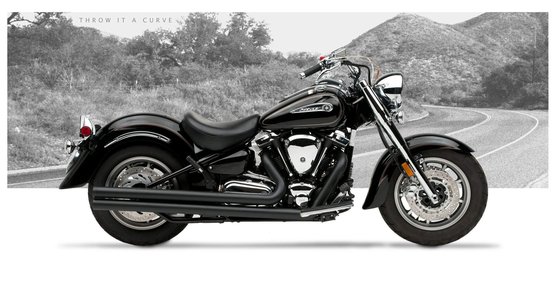
Yamaha borrowed braking tech from its sportier siblings, equipping the Road Star with dual 298mm front discs gripped by monoblock 4-piston calipers. The rear 320mm disc offers strong stopping power, though the linked system (common on competitors) is absent.
Suspension Setup:
- Front: 43mm telescopic forks with 5.5 inches (140mm) of travel absorb bumps competently.
- Rear: A horizontally mounted Monocross shock (adjustable for preload) delivers 4.3 inches (109mm) of travel. It’s firm enough for two-up riding but can feel harsh over sharp ridges.
While the brakes lack modern ABS, they’re progressive and easy to modulate—a testament to Yamaha’s tuning.
Competition: How the Road Star Stacks Up
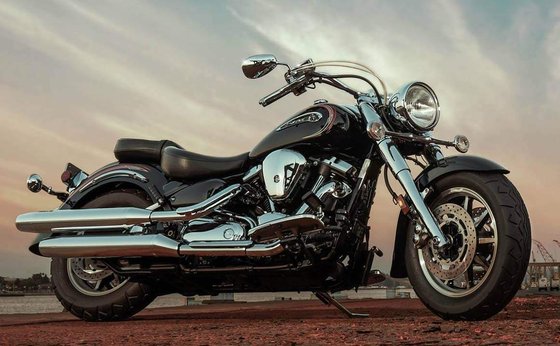
In the 2000s, the Road Star faced fierce rivals. Here’s how it compares:
1. Harley-Davidson Dyna Glide
- Pros: Stronger brand cachet, endless customization.
- Cons: Higher maintenance costs, inferior stock suspension.
- Verdict: The Road Star undercuts Harley in reliability and value, though it lacks the “badge prestige.”
2. Honda VTX 1800
- Pros: Larger engine, smoother shaft drive.
- Cons: Heavier, less agile, blander design.
- Verdict: The VTX is a brute, but the Road Star feels more engaging and retro-authentic.
3. Kawasaki Vulcan 2000
- Pros: Class-leading displacement, liquid cooling.
- Cons: Overweight, awkward ergonomics.
- Verdict: The Vulcan’s size becomes a liability in tight spaces, whereas the Road Star strikes a better balance.
Yamaha’s ace card? The Road Star’s belt drive and hydraulic lifters meant fewer maintenance headaches compared to chain-driven or shim-under-bucket rivals.
Maintenance: Keeping the Legend Alive
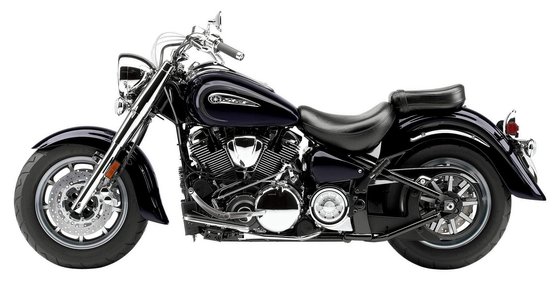
Owners praise the Road Star’s mechanical simplicity, but neglect is a killer. Here’s how to keep it thriving:
Critical Service Tips:
- Oil Changes: Use 15W-40 mineral or semi-synthetic oil every 3,000 miles (4,800 km). The spin-on filter (under the seat) is easy to access.
- Belt Inspection: Check for cracks or fraying every 5,000 miles (8,000 km). Replacements are rare but ensure proper tension (10–12mm deflection under 10kg force).
- Cooling Fin Cleaning: Remove debris from fins to prevent overheating—compressed air works wonders.
- Brake Fluid: Flush every two years, especially if storing over winter.
Common Upgrades at MOTOPARTS.store:
- Exhaust Systems: Swap the stock mufflers for Vance & Hines slip-ons to unleash the V-twin’s growl.
- Air Intake Kits: Boost mid-range punch with a high-flow filter and jet kit (carbureted models).
- Seats: Corbin or Mustang seats improve long-haul comfort.
- Lighting: LED auxiliary lights enhance visibility and add a custom flair.
Conclusion: The Road Star’s Enduring Appeal
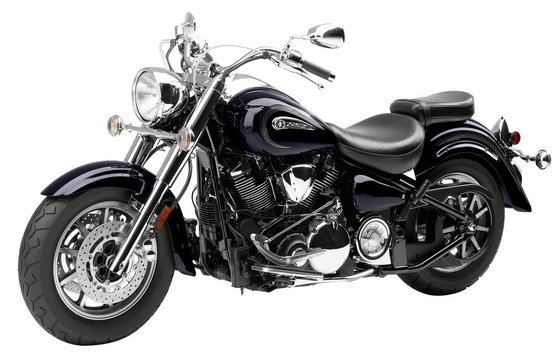
The Yamaha XV 1700 Road Star isn’t just a motorcycle—it’s a statement. It proves that raw torque, minimalist design, and bulletproof engineering can transcend trends. Whether you’re carving coastal highways or idling through town, this machine exudes a character that modern liquid-cooled giants struggle to replicate. For riders who value substance over specs and soul over software, the Road Star remains a benchmark.
At MOTOPARTS.store, we’re here to help you personalize, maintain, and elevate your Road Star experience. From performance upgrades to aesthetic tweaks, your cruiser deserves nothing less than legendary treatment.
Ride hard, ride long, and let the Road Star’s V-twin heartbeat remind you why we chase the horizon.







Specifications sheet
| Engine | |
|---|---|
| Stroke: | Four-stroke |
| Max torque: | 144 Nm |
| Fuel system: | Carburetor (Mikuni BSR40 CV) or Fuel Injection (40mm throttle body, depending on model year) |
| Displacement: | 1670 ccm |
| Max torque @: | 2500 rpm |
| Configuration: | V |
| Cooling system: | Air-cooled |
| Valve actuation: | OHV, hydraulic lifters |
| Compression ratio: | 8.4:1 |
| Number of cylinders: | 2 |
| Spark plugs per cylinder: | 2 |
| Dimensions | |
|---|---|
| Wheelbase: | 1689 mm (66.5 in) |
| Dry weight: | 312 |
| Wet weight: | 337 |
| Seat height: | 710 mm (28 in) |
| Overall width: | 980 mm (38.6 in) |
| Overall height: | 1140 mm (44.9 in) |
| Overall length: | 2499-2500 mm (98.4 in) |
| Ground clearance: | 145 mm (5.7 in) |
| Fuel tank capacity: | 20 L (5.3 US gal) [17 L (3.7 US gal) on some S models] |
| Drivetrain | |
|---|---|
| Belt type: | Narrow design for reduced weight and durability |
| Final drive: | Belt |
| Transmission: | 5-speed with overdrive 5th gear |
| Maintenance | |
|---|---|
| Air filter: | Paper type, side-mounted |
| Oil system: | Dry sump with spin-on filter |
| Brake fluid: | DOT 4 |
| Valve maintenance: | Hydraulic lifters (no manual adjustment required) |
| Recommended tire pressure (rear): | 2.5 bar (36 psi) solo / 2.8 bar (41 psi) with passenger |
| Recommended tire pressure (front): | 2.25 bar (33 psi) |
| Additional Features | |
|---|---|
| Wheels: | Cast aluminum 9-spoke (tubeless tires) or spoked (Canadian models) |
| Exhaust: | 2-into-2 staggered shotgun pipes |
| Lighting: | LED taillight, halogen headlight |
| Customization: | Multiple mounting points under rear fender, removable passenger seat |
| Instrumentation: | Tank-mounted speedometer with odometer, tripmeters, clock, and fuel gauge |
| Chassis and Suspension | |
|---|---|
| Frame: | Aluminum double-cradle |
| Rear tire: | 150/80-16 |
| Front tire: | 130/90-16 |
| Rear brakes: | Single 320mm disc with 4-piston caliper |
| Front brakes: | Dual 298mm discs with 4-piston calipers (ABS on some models) |
| Rear suspension: | Adjustable link Monocross, 110 mm (4.3 in) travel |
| Front suspension: | 43mm telescopic fork, 140 mm (5.5 in) travel |



